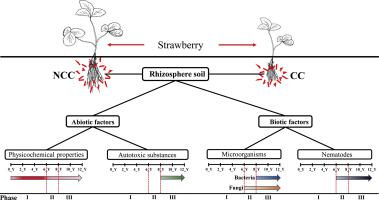当前位置:
X-MOL 学术
›
Appl. Soil Ecol.
›
论文详情
Our official English website, www.x-mol.net, welcomes your feedback! (Note: you will need to create a separate account there.)
Phase changes of continuous cropping obstacles in strawberry (Fragaria × ananassa Duch.) production
Applied Soil Ecology ( IF 4.8 ) Pub Date : 2020-11-01 , DOI: 10.1016/j.apsoil.2020.103626 Peng Chen , Yu-zhu Wang , Qi-zhi Liu , Yun-tao Zhang , Xing-yue Li , He-qin Li , Wei-hua Li
Applied Soil Ecology ( IF 4.8 ) Pub Date : 2020-11-01 , DOI: 10.1016/j.apsoil.2020.103626 Peng Chen , Yu-zhu Wang , Qi-zhi Liu , Yun-tao Zhang , Xing-yue Li , He-qin Li , Wei-hua Li

|
Abstract Soil ecology plays an important role in the growth and health of plants. Research suggests that long-term monocropping may lead to soil ecological disorders. In this study, we aimed to understand the reasons for the decrease in plant productivity stemming from long-term monoculture cropping. Greenhouse studies were conducted to determine the cause of continuous cropping (CC) obstacles in soils under 12 years of continuous strawberry (Fragaria × ananassa Duch.) production. The data suggested that CC led to three phases of changes in abiotic and biotic soil factors. In phase I (CC for 2–6 years), significant changes were observed only in soil physicochemical properties, such as the pH, total nitrogen (TN), ammonium nitrogen (NH4+-N), available phosphorus (AP), available potassium (AK) and soil organic matter (SOM), which obviously changed from the second year to the sixth year. In phase II (CC for 6–8 years), two biotic factors, key fungi such as Fusarium, Humicola and Arthrobotrys and soil nematodes, i.e., populations and communities of nematodes, started to change significantly in terms of their abundance. In phase III (CC for >8 years), the accumulation of phenolic acids, i.e., p-hydroxybenzoic acid (p-HBA), ferulic acid (FA), p-coumaric acid (p-CA) and cinnamic acid (CA), significantly inhibited crop growth, and the abundance of key bacteria, including Bacillus, Sphingomonas and Sphingopyxis, started to change significantly from the eighth CC year. The results in this study provide useful information for solving CC obstacles in strawberry production.
中文翻译:

草莓(Fragaria × ananassa Duch.)生产中连作障碍的相变
摘要 土壤生态对植物的生长和健康具有重要作用。研究表明,长期单作可能导致土壤生态紊乱。在这项研究中,我们旨在了解长期单一种植导致植物生产力下降的原因。进行温室研究以确定连续种植草莓 (Fragaria × ananassa Duch.) 12 年以下土壤中连作 (CC) 障碍的原因。数据表明CC导致非生物和生物土壤因子的三个阶段变化。在第一阶段(CC 2-6 年),仅观察到土壤理化性质的显着变化,如 pH、总氮(TN)、铵态氮(NH4+-N)、有效磷(AP)、有效钾( AK) 和土壤有机质 (SOM),从第二年到第六年明显变了。在第二阶段(CC 6-8 年),两种生物因子,镰刀菌、腐质霉和节肢动物等关键真菌和土壤线虫,即线虫的种群和群落,其丰度开始发生显着变化。在第三阶段(CC > 8 年),酚酸的积累,即对羟基苯甲酸 (p-HBA)、阿魏酸 (FA)、对香豆酸 (p-CA) 和肉桂酸 (CA) ,显着抑制作物生长,关键细菌的丰度,包括芽孢杆菌、鞘氨醇单胞菌和鞘氨醇杆菌,从 CC 8 年开始发生显着变化。本研究的结果为解决草莓生产中的 CC 障碍提供了有用的信息。Fusarium、Humicola 和Arthrobotrys 等关键真菌和土壤线虫,即线虫的种群和群落,其丰度开始发生显着变化。在第三阶段(CC > 8 年),酚酸的积累,即对羟基苯甲酸 (p-HBA)、阿魏酸 (FA)、对香豆酸 (p-CA) 和肉桂酸 (CA) ,显着抑制作物生长,关键细菌的丰度,包括芽孢杆菌、鞘氨醇单胞菌和鞘氨醇杆菌,从 CC 8 年开始发生显着变化。本研究的结果为解决草莓生产中的 CC 障碍提供了有用的信息。Fusarium、Humicola 和Arthrobotrys 等关键真菌和土壤线虫,即线虫的种群和群落,其丰度开始发生显着变化。在第三阶段(CC > 8 年),酚酸的积累,即对羟基苯甲酸 (p-HBA)、阿魏酸 (FA)、对香豆酸 (p-CA) 和肉桂酸 (CA) ,显着抑制作物生长,关键细菌的丰度,包括芽孢杆菌、鞘氨醇单胞菌和鞘氨醇杆菌,从 CC 8 年开始发生显着变化。本研究的结果为解决草莓生产中的 CC 障碍提供了有用的信息。酚酸,即对羟基苯甲酸(p-HBA)、阿魏酸(FA)、对香豆酸(p-CA)和肉桂酸(CA)的积累,显着抑制了作物的生长,关键细菌,包括芽孢杆菌、鞘氨醇单胞菌和鞘氨醇杆菌,从 CC 的第 8 年开始发生显着变化。本研究的结果为解决草莓生产中的 CC 障碍提供了有用的信息。酚酸,即对羟基苯甲酸(p-HBA)、阿魏酸(FA)、对香豆酸(p-CA)和肉桂酸(CA)的积累,显着抑制了作物的生长,关键细菌,包括芽孢杆菌、鞘氨醇单胞菌和鞘氨醇杆菌,从 CC 的第 8 年开始发生显着变化。本研究的结果为解决草莓生产中的 CC 障碍提供了有用的信息。
更新日期:2020-11-01
中文翻译:

草莓(Fragaria × ananassa Duch.)生产中连作障碍的相变
摘要 土壤生态对植物的生长和健康具有重要作用。研究表明,长期单作可能导致土壤生态紊乱。在这项研究中,我们旨在了解长期单一种植导致植物生产力下降的原因。进行温室研究以确定连续种植草莓 (Fragaria × ananassa Duch.) 12 年以下土壤中连作 (CC) 障碍的原因。数据表明CC导致非生物和生物土壤因子的三个阶段变化。在第一阶段(CC 2-6 年),仅观察到土壤理化性质的显着变化,如 pH、总氮(TN)、铵态氮(NH4+-N)、有效磷(AP)、有效钾( AK) 和土壤有机质 (SOM),从第二年到第六年明显变了。在第二阶段(CC 6-8 年),两种生物因子,镰刀菌、腐质霉和节肢动物等关键真菌和土壤线虫,即线虫的种群和群落,其丰度开始发生显着变化。在第三阶段(CC > 8 年),酚酸的积累,即对羟基苯甲酸 (p-HBA)、阿魏酸 (FA)、对香豆酸 (p-CA) 和肉桂酸 (CA) ,显着抑制作物生长,关键细菌的丰度,包括芽孢杆菌、鞘氨醇单胞菌和鞘氨醇杆菌,从 CC 8 年开始发生显着变化。本研究的结果为解决草莓生产中的 CC 障碍提供了有用的信息。Fusarium、Humicola 和Arthrobotrys 等关键真菌和土壤线虫,即线虫的种群和群落,其丰度开始发生显着变化。在第三阶段(CC > 8 年),酚酸的积累,即对羟基苯甲酸 (p-HBA)、阿魏酸 (FA)、对香豆酸 (p-CA) 和肉桂酸 (CA) ,显着抑制作物生长,关键细菌的丰度,包括芽孢杆菌、鞘氨醇单胞菌和鞘氨醇杆菌,从 CC 8 年开始发生显着变化。本研究的结果为解决草莓生产中的 CC 障碍提供了有用的信息。Fusarium、Humicola 和Arthrobotrys 等关键真菌和土壤线虫,即线虫的种群和群落,其丰度开始发生显着变化。在第三阶段(CC > 8 年),酚酸的积累,即对羟基苯甲酸 (p-HBA)、阿魏酸 (FA)、对香豆酸 (p-CA) 和肉桂酸 (CA) ,显着抑制作物生长,关键细菌的丰度,包括芽孢杆菌、鞘氨醇单胞菌和鞘氨醇杆菌,从 CC 8 年开始发生显着变化。本研究的结果为解决草莓生产中的 CC 障碍提供了有用的信息。酚酸,即对羟基苯甲酸(p-HBA)、阿魏酸(FA)、对香豆酸(p-CA)和肉桂酸(CA)的积累,显着抑制了作物的生长,关键细菌,包括芽孢杆菌、鞘氨醇单胞菌和鞘氨醇杆菌,从 CC 的第 8 年开始发生显着变化。本研究的结果为解决草莓生产中的 CC 障碍提供了有用的信息。酚酸,即对羟基苯甲酸(p-HBA)、阿魏酸(FA)、对香豆酸(p-CA)和肉桂酸(CA)的积累,显着抑制了作物的生长,关键细菌,包括芽孢杆菌、鞘氨醇单胞菌和鞘氨醇杆菌,从 CC 的第 8 年开始发生显着变化。本研究的结果为解决草莓生产中的 CC 障碍提供了有用的信息。

























 京公网安备 11010802027423号
京公网安备 11010802027423号